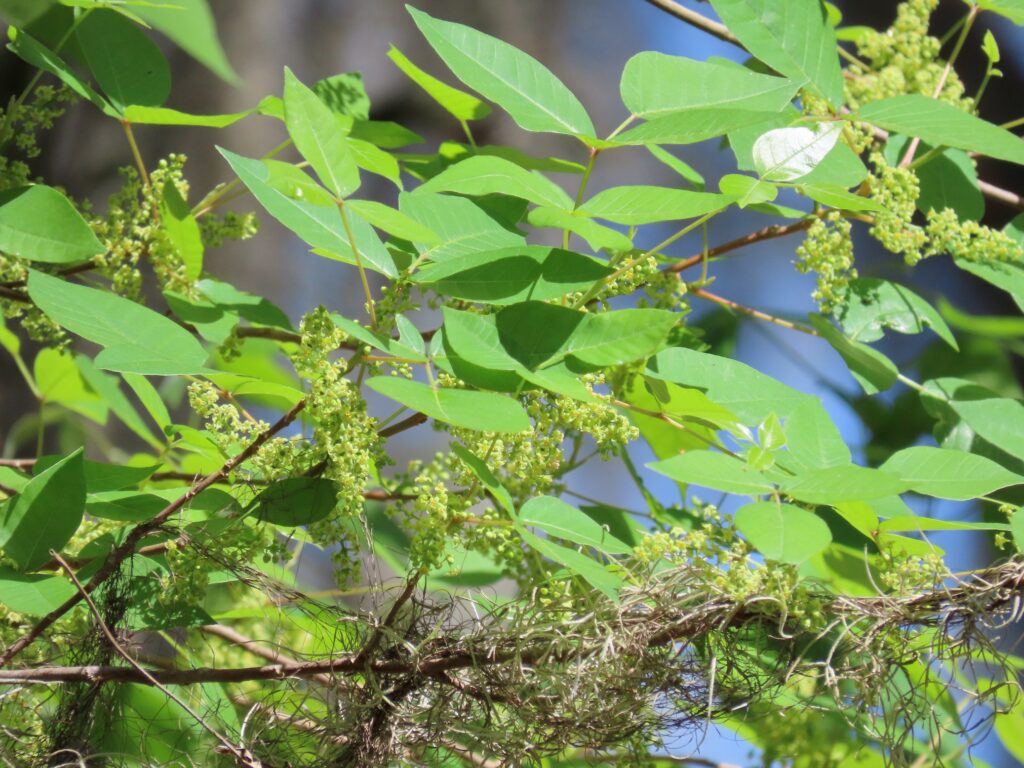




This week for Flora and Fauna Friday we have the most reviled vine in the Southeast, Poison-Ivy (Toxicodendron radicans).
Much maligned, this unsuspecting vine seems to be the scourge of all those would be wanderers of the woods. Few plants garner as visceral of a reaction from folks as today’s Poison-Ivy. However, I’m here today not just to tell cautionary tales but also to share the many merits of this persistently persecuted plant.
Poison-Ivy is found throughout the Eastern United States. It’s not a true Ivy but instead a relative of Cashews, Mangos, and Sumacs. Poison-Ivy, along with its cousins Poison-Oak (T. pubescens) and Poison-Sumac (T. vernix), can all be found in South Carolina. Poison-Oak grows as a small shrub and is partial to sandhills and Longleaf Pine Savannas. Poison-Sumac can grow into a small tree and is found on saturated soils along wetlands. Poison-Ivy grows primarily as a vine but can become a shrub on especially sandy soils or a groundcover in open areas. When growing as a vine, Poison-Ivy prefers to cling to the side of a tree using a profusion of tiny rootlets. These rootlets wriggle into the bark of the host tree, firmly anchoring the vine in place all the way up throughout the canopy. Poison-Ivy vines can eventually reach the size of your thigh, given enough time. These hairy vines are one of the key ways to identify Poison-Ivy at a glance. The other is by its leaves. Poison-Ivy leaves are compound with three leaflets, giving a vague resemblance to English Ivy, where it derives the “Ivy” part of its name. This three leaflet arrangement is consistent but the shape of the leaflets is not. The leaflets themselves can be highly glossy or nearly matte on the surface and their margins can be either straight, toothed, or semi-lobed.
Poison-Ivy provides many benefits to wildlife. In late April into May it blooms with clusters of greenish-white flowers enjoyed by a wide array of pollinating species. Further on into late summer, the fruits of their pollinated flowers mature into tiny off-white drupes, which are scoffed down by many of our songbirds. These birds then scatter the seeds of Poison-Ivy far and wide. Come fall, the deciduous leaves of Poison-Ivy are shed with an autumnal display of crimson and blood-orange. However, before that foliage is shed, it can be eaten by a wide variety of foraging mammals including Deer, Woodrats, and Raccoons, all of whom are unaffected by the Poison of this Ivy. Which leads us to the reason why most of us despise this plant.
Every part of the Poison-Ivy plant contains a compound called Urushiol. It is especially concentrated in the sap of the plant. (This compound is also produced by Poison-Oak and Poison-Sumac as well as certain parts of Cashew and Mango trees.) When a person leans against the trunk of a Poison-Ivy vine, steps on its leaves, digs up a root, or stands inside smoke from a brush fire containing the vines, then they may experience what’s called Urushiol-induced contact dermatitis. For those uninitiated, it’s one wicked rash and not something to take lightly. Symptoms generally manifest a day or two after exposure and can take several weeks to clear out. This is actually an allergic reaction happening under the skin after the Urushiol dissolves down into the dermis. The only way to prevent the reaction is to wash all exposed skin with a special soap before the Urushiol can absorb into the skin. Every individual has a different tolerance to Urushiol and severity of reaction. Some people are almost entirely immune and others can have horrible reactions from the most minimal of contact. Generally, your sensitivity increases with age and after each exposure.